Science Highlights, May 27, 2015
Awards and Recognition
Accelerator Operations and Technology
First in situ x-ray diffraction of explosives during impact at the Advanced Photon Source
Earth and Environmental Sciences
Next Generation Ecosystem Experiment Arctic Project yields new publications
Materials Physics and Applications
Neutron scattering studies the response of polymer films to high mechanical stresses
Materials Science and Technology
Oxygen-deficient BaTiO3-x as an efficient bifunctional oxygen electrocatalyst
Awards and Recognition
Eric Doors and Christopher Fryer win E. O. Lawrence awards
The DOE has selected Eric Dors (Emerging Threats, GS-ET) and Christopher Fryer (Computational Physics and Methods, CCS-2) to receive two of the nine annual Ernest Orlando Lawrence Awards to be given this year. The award recognizes mid-career U.S. scientists and engineers for exceptional R&D contributions supporting the DOE and its mission.
The Ernest Orlando Lawrence Award was established in 1959 in honor of the scientist who helped elevate American physics to world leadership through invention of the cyclotron, for which he received a Nobel Prize. The Lawrence Award is given in each of nine categories: Atomic, Molecular, and Chemical Sciences; Biological and Environmental Sciences; Computer, Information, and Knowledge Sciences; Condensed Matter and Materials Sciences; Energy Science and Innovation; Fusion and Plasma Sciences; High Energy Physics; National Security and Nonproliferation; and Nuclear Physics. The DOE Office of Science administers the awards. Each category winner receives a citation signed by the Secretary of Energy, a gold medal bearing the likeness of Lawrence, and a $20,000 honorarium. The honorarium is shared equally if there are co-winners in a category.
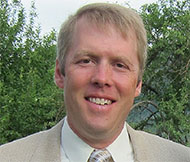
Eric Dors
Eric Dors was honored in the National Security and Nonproliferation category for developing a new generation of exo-atmospheric radiation sensors to fulfill a critical mission need for satellite-based nuclear explosion monitoring crucial to DOE’s nonproliferation mission of global nuclear detonation monitoring and verification of the Limited Test Ban Treaty. Citation “For technical leadership and systems engineering integration of next generation satellite-based nuclear explosion sensing and detection systems, and for its impact to the nonproliferation mission.”
Dors earned a PhD in physics from the University of New Hampshire and joined the Lab in 1998. He specializes in detector and spectrometry development, including space plasma spectrometers for solar wind, magnetospheric, and ionospheric measurements; energetic particle instruments for magnetospheric measurements; and exploitation of new technologies such by space-based sensors. Dors is a program manager for Department of Defense and Intelligence Community space programs within the Laboratory’s Emerging Threats program office. Technical contact: Eric Dors
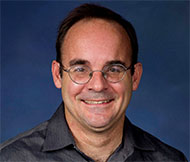
Christopher Fryer
Christopher Fryer was honored in the Fusion and Plasma Sciences category for his major advances addressing fundamental questions in astrophysics, computational multiphysics, and high-energy density science. His 3-D supernova core collapse simulations explain and predict astrophysical observations (NASA’s Swift mission) and phenomena. Citation: “For seminal advances in theory and modeling answering fundamental questions in astrophysics, for achievement in computational multiphysics, and for contributions impacting high-energy density science.”
Fryer received a PhD in astronomy from the University of Arizona and joined the Lab as the first Feynman Fellow 15 years ago. His computational astrophysics work involving the largest explosions in the universe has impacted some of the most important open questions in astrophysics, including the origin of the elements, the nature and evolution of the first stars, the gravitational wave signals from compact binary systems, and the mechanism responsible for gamma ray bursts. Fryer also extends computer code capabilities in verification and validation for nuclear stockpile science. He is a Fellow of the American Physical Society and the Laboratory. Technical contact: Christopher Fryer
Daekyoung Kang receives Baekchun award
Daekyoung Kang
The Korean Physical Society has honored Daekyoung Kang (Nuclear and Particle Physics, Astrophysics and Cosmology, T-2) with a 2015 Baekchun award. The society established the Baekchun award in honor of Professor Jihn E. Kim of Seoul National University. The award is given annually to recognize an outstanding young Korean physicist under 40 years old and to encourage young researchers in theoretical particle physics.
Kang earned a PhD degree in physics from the Ohio State University. He worked as a postdoctoral researcher at the Massachusetts Institute of Technology, and then joined T-2 at the Lab in 2014 as a Director’s Postdoctoral Fellow. His work investigates effective field theories of the strong interaction associated with phenomena in high-energy particle colliders and its application to a strongly interacting cold atomic system. This work serves as a model system for strongly interacting quantum matter such as high-Tc superconductors and neutron stars. Technical contact: Daekyoung Kang
James Wendelberger elected chair of an American Statistical Association section
James Wendelberger
The American Statistical Association (ASA) section on physical and engineering sciences has chosen James Wendelberger (Nuclear Material Control and Accountability, SAFE-4) as chair-elect for 2016 and chair in 2017. Wendelberger will take office on January 1, 2016. He earned a PhD in statistics from the University of Wisconsin and joined the Laboratory in 2013.
The American Statistical Association is the world’s largest community of statisticians. The ASA supports excellence in the development, application and dissemination of statistical science through meetings, publications, membership services, education, accreditation and advocacy. American Statistical Association members serve in industry, government and academia in more than 90 countries, advancing research and promoting sound statistical practice to inform public policy and improve human welfare. Technical contact: James Wendelberger
Accelerator Operations and Technology
First in situ x-ray diffraction of explosives during impact at the Advanced Photon Source
By capturing the first x-ray diffraction patterns of explosives in situ during gas-gun driven impact loading using synchrotron radiation, Los Alamos researchers and collaborators demonstrated a crucial diagnostic for studying how crystalline explosives deform under shock loading. This represents one of the first experimental steps toward developing next-generation, physics-based mesoscale models with predictive capability for high explosives to support associated Science Campaign 2 milestones scheduled through FY 2023.
Scientists think that crystalline deformation in high explosives controls the size, temperature, and possibly also the spatial distribution of “hot spots,” which lead to shock-induced reaction and detonation initiation. In this study, the researchers used the synchrotron at Argonne National Laboratory’s Advanced Photon Source (APS) to measure x-ray diffraction in situ during shock loading. The work investigated high rate crystalline mechanics in single crystal RDX (cyclotrimethylene trinitramine, an explosive).
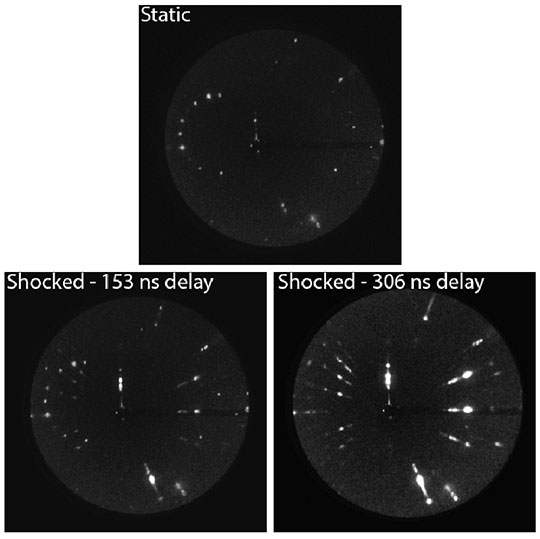
Figure 11. X-ray diffraction patterns from {021}-oriented RDX sample.
Next steps include analyzing the x-ray diffraction patterns and comparing them to results from recently developed finite element model simulations of the crystalline deformation during shock loading. The analysis will enable the extraction of previously unattainable equation-of-state information and the development and validation of an anisotropic plasticity model crucial for predicting thermomechanical localization of deformation and associated heating.
The research team includes: Kyle Ramos, Brian Jensen, Timothy Pierce, Virginia “Tate” Hamilton, Claudine Armenta, Charles Owens (Shock and Detonation Physics, M-9); Marc Cawkwell, John Barber (Physics and Chemistry of Materials, T-1); D. J. Luscher, Frank Addessio (Fluid Dynamics and Solid Mechanics, T-3); Adam Iverson (National Security Technologies LLC, NSTEC); and Nick Sinclair and Thomas Gog (Dynamic Compression Sector, Advanced Photon Source).
Developing capabilities for making, measuring, and modeling materials and demonstrating the extent of mission relevant information that can be extracted from in situ experiments envisioned at the proposed MaRIE Signature Science Facility is important and timely for the Laboratory. The Materials In Extremes exploratory research funding for this Laboratory Directed Research and Development (LDRD) project enabled the experimental development of the x-ray diffraction and complimentary multi-scale modeling capabilities and benefited from the unique national resource for single crystal growth at the Lab’s High Explosives Crystal Lab. The x-ray diffraction capabilities created using LANL’s IMPact system for ULtrafast Synchrotron Experiments (IMPULSE) and applied here to explosives will be used to study other materials, including metals, within the fiscal year. The research supports the Lab’s Nuclear Deterrence mission area and the Materials for the Future and Science of Signatures science pillars through studies of materials in extreme environments for Stockpile Stewardship. Technical contact:Kyle Ramos
Bioscience
Function discovery platform for transcriptional regulators
The large-scale genome sequencing efforts by the DOE/Joint Genome Institute and others has resulted in sequences for close to 10,000 bacterial genomes. The work’s most profound outcome is the revelation of how little is known about the functions of a very large fraction of genes in every organism. More sequencing alone will not solve this problem. Even in E. coli, the most comprehensively studied organism, a complete functional description cannot be assigned to over 50% of the protein-encoding genes. The genes with unknown function are divided into three main classes: 1) genes encoding for non-catalytic proteins (such as structural proteins and transcriptional factors), 2) genes encoding for enzymes catalyzing biochemical reactions in pathways that have not yet been discovered, and 3) genes encoding for enzymes catalyzing reactions in known pathways (orphan enzymes). To derive phenotype (observed properties resulting the interaction of the genetic makeup with environment) from genotype (genetic makeup of the organism), scientists must have a complete understanding of cellular function. This will require a detailed understanding of each individual gene/protein function (specific activity), their involvement in metabolic pathways or networks, and the overall genetic and biochemical regulation governing these pathways and networks. The presence of thousands of conserved genes of unknown function means that a large fraction of the biochemistry and physiology cannot be inferred simply by analyzing genome sequences. Solving this problem is one of the great challenges that biochemists face. Understanding how the information contained in genes manifests as an organism’s traits, the phenotypes, remains one of the main challenges for systems biology. Laboratory scientists addressed this issue in a paper published in BMC Genomics.

Figure 1. Bacterial Transcriptional Regulators (TRs) control transcription by positively or negatively regulating protein expression. The binding of TRs to the DNA is determined by the concentration of an Effector, which is often a product of the biochemical pathway. Binding of the Effector to the TR generates a binary complex responsible to promote or repress gene transcription. The figure depicts an example of TR mediated gene repression.
The interdisciplinary Lab team designed, created, and validated a hybrid platform for the discovery of biological function of proteins with unknown function with special focus in transcriptional regulators. The authors invented a gene neighborhood examination tool called “Function Discovery V1.0”. This software identifies co-locations of genes within genomic neighborhoods across many organisms, associates them with their respective metabolic pathways, and by doing so, connects the pathways with their respective transcriptional regulators (TR). The software rapidly identifies and compares conserved genomic neighborhoods encoding for metabolic pathway enzymes across many organisms and identifies candidate pathways in which the unknown function proteins (TRs) may participate.
The authors surpassed the theoretical prediction boundaries by creating a systematic approach that allowed them to test the discovery predictions and fully characterize the biological function of TRs of unknown function (effector and DNA operator). The approach tested metabolites within the predicted metabolic pathway for binding. The team used a mass spectrometry-based platform, screened for the DNA operator using microarrays, and confirmed the triad (Effector/TR/DNA operator) regulatory activity using electrophoretic and fluorescence techniques. The creation of a systems biology approach for the discovery, prediction, and validation of unknown protein function is a significant leap in our ability to understand living organisms. This approach will help close the gap between gene sequence and protein function – allowing scientists to begin deriving phenotype from genotype.
Reference: “Automated Genomic Context Analysis and Experimental Validation Platform for Discovery of Prokaryote Transcriptional Regulator Functions,” BMC Genomics 15, 1142 (2014); doi:10.1186/1471-2164-15-1142. http://www.biomedcentral.com/1471-2164/15/1142
Authors include: Ricardo Martí-Arbona, Kristy L. Nowak-Lovato, Melinda S. Wren, Pat J. Unkefer and Clifford J. Unkefer (Bioscience Division); and Fangping Mu (Theoretical Division).
Laboratory Directed Research and Development (LDRD) funded the work, which supports the Global Security mission area and the Science of Signatures science pillar through insight into the link between gene sequence and protein function. Technical contact: Ricardo Martí-Arbona
Capability Enhancement
New data transfer system released for the Turquoise Network
The Laboratory has unveiled the new Turquoise network Data Transfer Node (DTN) system. This system enables Lab researchers to transfer data sets into and out of the Turquoise network with partner institutions at significantly higher bandwidths than were previously available. The new system complements the high performance computing and DISC (Data Intensive Supercomputing) capabilities currently installed in, as well as projected for, the Turquoise network.
This new system is comprised of eight servers that run the Globus file transfer software (www.globus.org) and an additional two servers that allow for other transfer mechanisms such as scp or bbcp (a tool developed at SLAC to copy files quickly from the particle accelerator). These servers have a high-bandwidth path through the BMC Genomics Laboratory’s new 100Gbps connection to ESNet (the Lab’s internet service provider). This is a huge improvement compared with the previous Turquoise network file transfer servers that were connected to the lab’s 10Gbps ESNet connection, and lacked an easy to use interface like Globus.
The development and roll out of this service began in January of 2014 at the request of the Associate Directorate of Theory, Simulation, and Computation (ADTSC) management. Requests from Turquoise network end users guided the development. These end users described how their experiments required more data and more frequent interaction with non-LANL collaborators. This necessitated increased data transfers with partners at other institutions.

Figure 2. Screen view of the new service.
Current partner sites for data transfer using the Globus protocol include: Argonne Leadership Computing Facility, National Center for Atmospheric Research, National Energy Research Scientific Computing Center, Oakridge Leadership Computing Facility, and National Center for Supercomputing Applications. Users who want to take advantage of the new service can find more information on the Lab’s HPC wiki (hpc.lanl.gov/dtn) or speak with HPC Consulting (5-4444, option 3) for details and directions for requesting an account. If a site is not already allowed, users can request an additional remote site.
Kyle Lamb (High Performance Computer Systems, HPC-3), Christopher Mitchell (HPC-3, previously Applied Computer Science, CCS-7), and Brett Kettering (System Integration, HPC-5) led a large team of individuals across High Performance Computing (HPC), Computer, Computational, and Statistical Sciences (CCS), and Network and Infrastructure Engineering (NIE) divisions.
The Laboratory’s Institutional Computing funded the work. The enhanced capability supports the Lab’s mission areas and the science pillars that require data transfer with external collaborators on projects. Technical contacts: Christopher Mitchell, Kyle Lamb, and Brett Kettering
Chemistry
Radiation effects on polymers
Polymer-based materials used in Lab applications are subjected to environmental conditions that may adversely impact their performance and stability. This potential material degradation requires a good understanding of the diverse factors that may influence the polymer physical and chemical properties. It is important to understand changes in structural-rheological (flow) property relationships that are triggered by exposure to harsh environments, especially gamma radiation. Polymer exposure to gamma radiation under inert conditions forms chemical radical species, which react to create cross-linked polymers. Cross-linked polymers exhibit enhanced strength, resistance to stress cracking, and improved thermal stability. Conversely, polymer exposure to gamma radiation in air drives an oxygen-radical reaction that degrades polymer structure and weakens the material. Two papers in Polymer Degradation and Stability by LANL scientists and collaborators reported changes in polymer-based materials based on environmental conditions.
In studies to understand radiation damage mechanisms, the team exposed a series of polymer foams, binders, and composites to gamma irradiation at the Sandia Gamma Irradiation Facility (GIF). The scientists investigated radiation-induced changes in polymer chemistry, thermal properties, phase behavior, microstructure, and mechanical response via an extensive suite of analytical tools that included mass spectroscopy, solid and solution-state nuclear magnetic resonance (NMR), Mössbauer spectroscopy, electron paramagnetic resonance, solvent swelling, differential scanning calorimetry, thermogravimetric analysis, image techniques, and mechanical testing. Gamma exposure of room temperature vulcanized (RTV) siloxane foams induced cross-linking reactions that predominated over degradation reactions. No radiation-induced chemical radicals were detected, and the porous structure of the gamma-irradiated foam remained unchanged. Radiation exposure resulted in gas evolution, decrease in crystallization levels, slight changes in chemistry, and an increase in cross-link density, thereby hardening the foam. Conversely, gamma exposure of a polymeric resin currently used in Additive Manufacturing (AM) to print pads and cushions revealed low tolerance to gamma radiation. This result prompted the team to develop new 3-D printable resins with unique, improved chemical and physical characteristics.
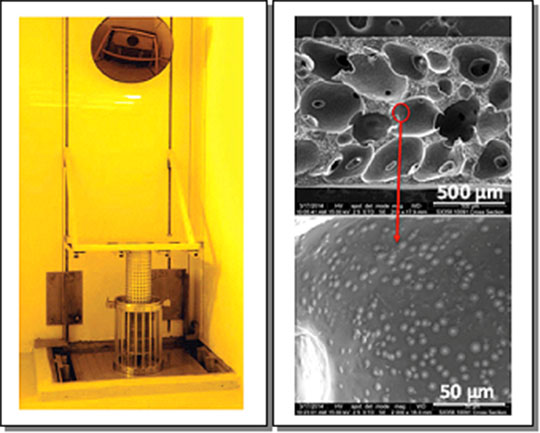
Figure 3. (Left panel): The Gamma Irradiation Facility has cobalt-60 sources and three exposure cells that provide different test configurations, dose rates, and dose levels. The yellow color comes from the leaded glass that is required to block radiation. (Right panels): Scanning electron microscopy images of RTV foam show the porous structure.
References: “Gamma Irradiation and Oxidative Degradation of a Silica-filled Silicone Elastomer,” Polymer Degradation and Stability 116, 62 (2015); doi: 10.1016/j.polymdegradstab.2015.03.009. Authors include: Andrea Labouriau, John Gill, and Denisse Ortiz-Acosta (Chemical Diagnostics and Engineering, C-CDE); Carl Cady (Materials Science in Radiation and Dynamics Extremes, MST-8); Jamie Stull, Kevin Henderson, and Vaughn Hartung (Engineered Materials, MST-7); Adam Quintana and Mathew Celina (Sandia National Laboratories).
“The Effects of Gamma Irradiation on RTV Polysiloxane Foams,” Polymer Degradation and Stability 117, 75 (2015); doi: 10.1016/j.polymdegradstab.2015.03.021. Authors include: Andrea Labouriau and John Gill (C-CDE), Carl Cady (MST-8), Dean Taylor (Condensed Matter and Magnet Science, MPA-CMMS), Adam Zocco, Jamie Stull, Kevin Henderson, and Debra Wrobleski (MST-7).
The NNSA Enhanced Surveillance Campaign funded the research, which supports the Lab’s Nuclear Deterrence mission area and the Materials for the Future science pillar through development of materials with enhanced properties for specific environments. Technical contact: Andrea Labouriau
Earth and Environmental Sciences
Next Generation Ecosystem Experiment Arctic Project yields new publications
The Arctic may be the most climatically sensitive region on Earth. The DOE Next-Generation Ecosystem Experiment (NGEE-Arctic) project aims to improve climate model predictions through advanced understanding of coupled processes in Arctic terrestrial ecosystems. The goal is to reduce uncertainty in climate prediction through improved representation of critical tundra processes. Two publications by Laboratory researchers and collaborators provide new insight into chemistry in the Arctic as well as improved surface/subsurface modeling of permafrost thermal hydrology.
The first article, published in Geophysical Research Letters, describes the first comprehensive spatial examination of active layer chemistry in Arctic polygonal ground, is a signature characteristic of many Arctic landscapes (Figure 4). However, there has been no systematic investigation of active layer chemistry within polygonal ground systems that examines polygon type (high- and low- centered), features (troughs and centers), and depth (surface water, shallow subsurface, and at the deepest part of the active layer). Understanding variations in active layer chemistry is essential due to the tight coupling between geochemistry and a variety of Arctic ecosystem processes and characteristics such as distributions of plant types, nutrient cycling, and greenhouse gas production.
The team created an extensive database of active layer water chemistry in the Arctic coastal plain near Barrow, Alaska. The database included water chemistry measurements of 54 different analytes from surface waters and active layer pore waters. Statistical tests examined chemical differences between polygon types, polygon features, and with depth. The chemistry across the different types of microtopography varies substantially. Multiple significant differences between high- and low-centered polygons suggest that polygon types may be useful for landscape-scale geochemical classification. However, differences in polygon features for analytes that were not significant for polygon type indicate that finer-scale features affect biogeochemistry differently from polygon types. Depth variations reveal multidimensional aspects of polygonal ground biogeochemistry. The results have major implications for understanding how polygonal ground ecosystems function, and how they may respond to future change.
Reference: “Microtopographic and Depth Controls on Active Layer Chemistry in Arctic Polygonal Ground,” Geophysical Research Letters 42, 1808 (2015); doi:10.1002/2014GL062804. Authors are: B. Newman, H. Throckmorton, J. Heikoop, and C. Wilson (Earth System Observations, EES-14); D. Graham, B. Gu, L. Liang, S. Wullschleger (Oak Ridge National Laboratory); S. Hubbard and Y. Wu, (Lawrence Berkeley National Laboratory); E. Herndon (Oak Ridge National Laboratory, now at Kent State University); T. Phelps and S. Wullschleger (Oak Ridge National Laboratory, now at University of Tennessee).
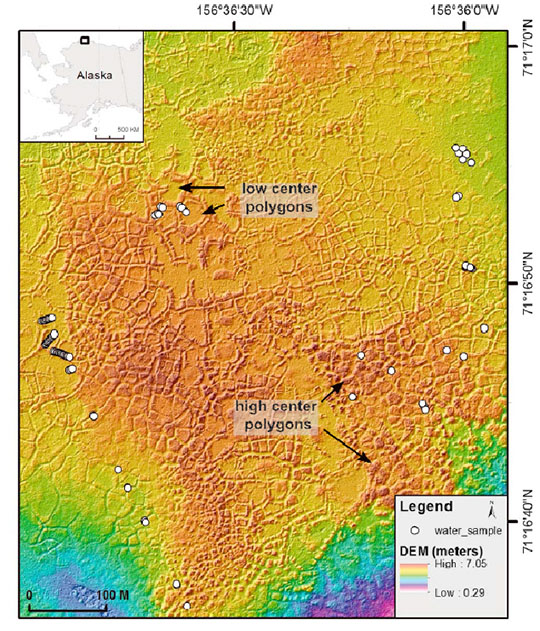
Figure 4. Polygonal ground surface at the Barrow Environmental Observatory displayed using 0.5m resolution LiDAR (Light Detection and Ranging) imagery. White circles indicate active layer sampling locations.
The second paper, published in Geoscientific Model Development discusses a ModEx (Method of Direction estimation) approach to development and calibration of the surface/subsurface Advanced Terrestrial Simulator (ATS) model for permafrost thermal hydrology that incorporates subsurface temperature and snow measurements in the model refinement process (Figure 5).
The team combined observational and computational in the iterative model refinement procedure to evaluate and parameterize different model processes necessary to simulate freeze/thaw processes and active layer thickness formation. The ModEx procedure cycled between borehole temperature, snow cover measurements and calibration simulations. The researchers evaluated the adequacy of the model structure by assessing whether or not calibrated parameters are reasonable. If calibrated parameters were outside ranges considered reasonable based on previous studies and measured values, the scientists changed the conceptual model or process representation to address this evident model inadequacy. The ModEx cycles identified process representations necessary to simulate active layer thickness dynamics at the fine scale. Thermal conductivity, conceptualization of surface and subsurface saturation states, and snowpack depth and deformation affected how well simulated subsurface temperatures matched measured data, and the ability of the model to calibrate to realistic parameters. The refined model identified data needs from future observational studies. For example, the team identified information on lateral flow and snowpack evolution as critical constraints on model representations of surface hydrology and energy fluxes through the snowpack. This work is currently published as a Discussion Paper and is available for interactive discussion until 10 June 2015. Following the open review and discussion, final responses will be submitted by the authors in preparation for peer-review completion and publication.
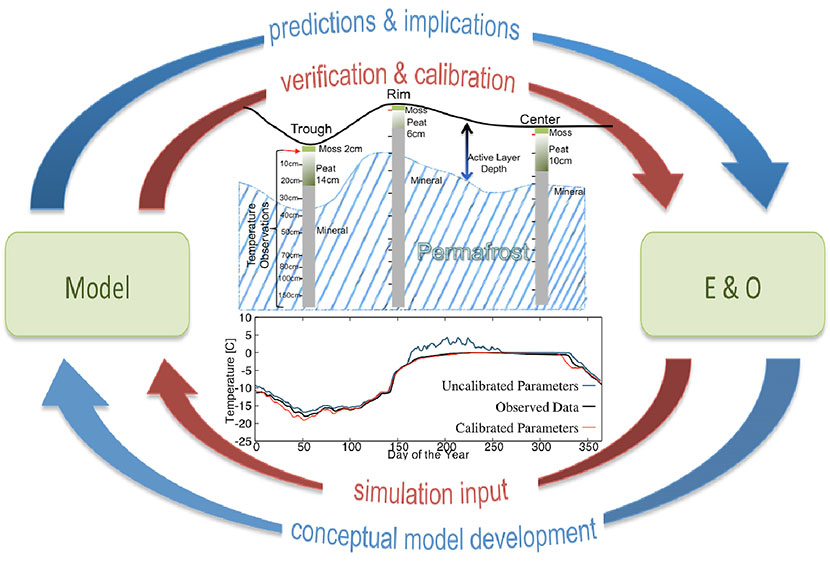
Figure 5. Schematic of the ModEx cycle surrounding the conceptual model and plots comparing uncalibrated, calibrated, and observed temperature at 40 cm depth from Barrow, AK.
Reference: “Using Field Observations to Inform Thermal Hydrology Models of Permafrost with ATC (v0.83), Geoscientific Model Development 8, 3235 (2015); (link to discussion) - doi: 10.5194/gmdd-8-3235-2015, 2015. Authors include: A. L. Atchley, D. R. Harp, and E. T. Coon (Computational Earth Science, EES-16); S. L. Painter (Oak Ridge National Laboratory); C. J. Wilson (EES-14); A. Liljedahl and V. E. Romanovsky (University of Alaska).
Laboratory Directed Research and Development (LDRD) and the DOE Office of Science, Office of Biological and Environmental Research funded different aspects of the work. The research supports the Lab’s Energy Security mission area and the Information, Science, and Technology and Science of Signatures science pillars through development of simulation and prediction of the effects of climate change. Technical contacts: Brent Newman and Adam Atchley
Materials Physics and Applications
Neutron scattering studies the response of polymer films to high mechanical stresses
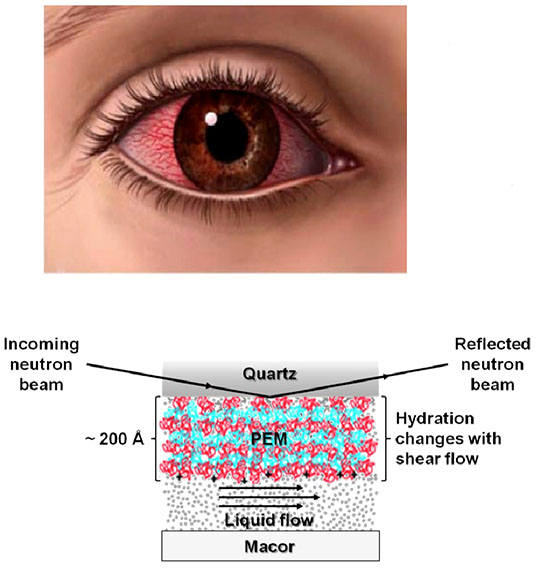
Figure 6. The ability of neutron reflectometry to probe fluidic shear effects on polymer electrolyte thin films benefits applications where polymeric structures experience dramatic flow shear stresses. (Top): The surface of a contact lens can experience shear rates as strong as 30,000 s-1 due to a moving eyelid. Natural deficiencies in certain lubricating bio-molecules can lead to dry eye syndrome and inflamed conjunctiva. (Bottom): Model system mimics the cornea surface under the shear stress.
Polymers are essential components in a range of items – from cosmetics and biocompatible surfaces of prosthetics to weapon components. However, the effect of fluid shear effect on the structure and properties of polymer thin films and mesoscopic assemblies has not been adequately investigated. Understanding these stresses is essential to increasing thin film applications, which range from materials science to biology and medicine, where bio-mechanical forces cause many critical processes.
The Laboratory, University of South Florida, and Alcon/Vision Care Company used the Surface Profile Analysis Reflectometer (SPEAR) beamline at the Los Alamos Neutron Science Center to investigate the effect of fluidic shear on polymer electrolytes thin films. The team utilized neutron reflectometry, one of the few physical probes with sufficient nanometer-scale resolution, penetrability, and sensitivity to address the properties of ultra-thin polymeric coatings in contact with flowing liquid and the stresses to which they are subjected.
The journal Langmuir published their research, which raised important questions regarding the behavior of water molecules hydrating polymeric chains and their response to external stresses, especially in non-equilibrium states. Water is one of the most common substances on Earth and is vital for many physico-chemical processes including all known life forms. An enhanced understanding into its properties, especially in the nano- and meso-scales, is of great importance. Neutron surface scattering, aligned with the capabilities of MaRIE (Matter-Radiation Interactions in Extremes), the Laboratory’s proposed facility for materials studies at the mesoscale, is an experimental approach that will address such time-dependent, soft-material problems.
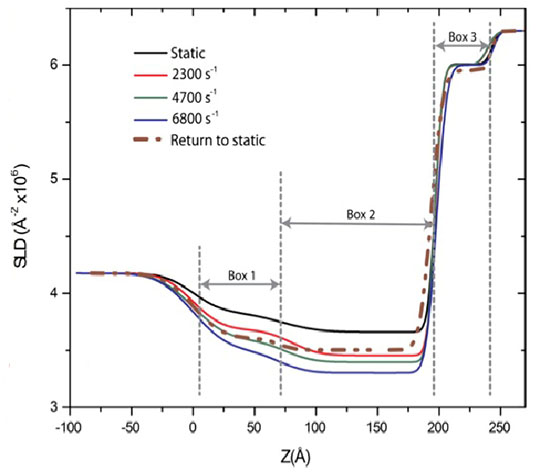
Figure 7. Neutron reflectometry results show the response of the polymeric meso-structure to the external fluid shear.
Surface properties are very important for implantable biomaterials and tissue engineering. These properties influence tissue and cellular events such as protein adsorption, cell adhesion, and inflammatory response. Creating composite nanostructures – by combining different poly-ions, nanoparticles, enzymes, proteins, and DNAs – increases the applications where such thin films can be used. Estimating the damages/changes within such devices induced by shear stresses is critical for their design and optimization. Fluidic shear stress can be significant: compared to ~500 s-1 shear rates in a fire hose, shear rates in the human body due to blood flow reach up to ~1500 s-1 in capillaries and arterioles. In the human ocular systems shear rates can reach up to 30000 s-1 depending on tear film thickness (usually in μm range) and blink velocity (usually tens of cm/s).
Poly-electrolytes are charged water-soluble polymers, which are used to coat solid surfaces in a technique where oppositely charged polymeric films are consecutively deposited through appropriate polymer-water solutions. The team investigated the response of these mesoscale thick films, consisting of alternating polyethylene imine and polystyrene sulfonate layers coated on a quartz substrate, to fluid shear. The scientists used neutron surface scattering probes for the studies. The high penetrability of neutron reflectometry allows examination of buried solid-liquid interfaces, favorable scattering contrast (polymers are mostly built of carbons and hydrogen with which neutrons strongly interact), angstrom-scale resolution, and lack of beam damage. Thus neutrons present an ideal tool to study mesoscale structures in contact with fluids.
The neutron reflectometry results showed several unexpected results. For example, a monotonic decrease of the volume fraction of hydrating water inside the polymer film occurs with increasing shear rate, and an approximate 7% uniform water volume fraction decrease throughout the film for the highest shear rate applied (~7000 s-1) occurs. The water content decrease does not cause any significant changes in the total polymer thickness. This phenomenon creates a significant negative osmotic pressure in the film. The polymers returned to their native state after the shear stress is relieved.
Reference: “Effects of Fluid Shear Stress on Polyelectrolyte Multilayers by Neutron Scattering Studies,” by Langmuir 31, 2870 (2015); doi: 10.1021/acs.langmuir.5b00037. Authors are: Ann Junghans (Engineered Materials, MST-7), Saurabh Singh and Jaroslaw Majewski (Center for Integrated Nanotechnologies, MPA-CINT), Erik Watkins (Materials Synthesis and Integrated Devices, MPA-11), Yash Kapoor (Alcon), and Ryan Toomey (University of South Florida).
This work benefited from the use of the Lujan Neutron Scattering Center at LANSCE funded by the DOE Office of Basic Energy Sciences and Los Alamos National Laboratory under DOE Contract DE-AC52-06NA25396. The research supports the Laboratory’s overall national security mission and Materials for the Future and Science of Signatures science pillars. Technical contact: J. Majewski
Materials Science and Technology
Oxygen-deficient BaTiO3-x as an efficient bifunctional oxygen electrocatalyst
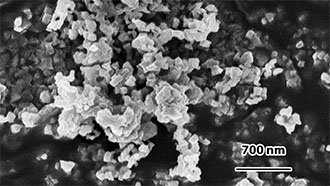
Figure 8. Scanning electron micrograph image for a typical oxygen-deficient BaTiO3-x catalyst particle. State-of-the-art iridium oxide (IrO2) catalysts, used for reference, have excellent OER activity comparable or even better than earlier reports.
Development of cost-effective and highly active catalysts for electrochemical energy storage and conversion applications is a critical element in currently studied sustainable energy technologies. Metal-air batteries represent the most promising energy storage systems for portable electronics, electrical vehicles, and stationary applications for storing the clean energy obtained from wind, solar, and power plants.
Unlike the traditional intercalation electrodes in lithium-ion batteries, the porous air cathode in the metal-air cell is capable of taking reactant oxygen (O2) from the atmosphere, instead of storing it in the electrodes. The unique configuration results in a vastly improved theoretical specific energy density of 1086 Wh·kg−1 for zinc-air and 5028 Wh·kg−1 for lithium-air batteries, two of the most promising metal-air systems. However, these advanced electrochemical energy technologies greatly rely on the oxygen reduction reaction (ORR) and oxygen evolution reaction (OER), a pair of the most important and technologically pertinent electrochemical reactions. Unfortunately, the ORR and OER typically have very high overpotentials with slow kinetics, requiring catalysts containing large amount of precious metals such as platinum and iridium. The prohibitive expense and limited supply of these precious metals make unsustainable catalysts for modern society.
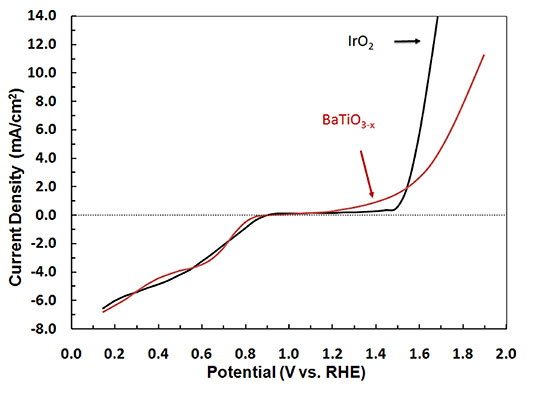
Figure 9. Steady-state polarization plots of the oxygen reduction reaction and oxygen evolution reaction for IrO2 and BaTiO3-x catalysts in 0.1 M NaOH electrolyte at 25°C and 900 rpm.
Perovskite oxides are nonprecious metal catalysts that have emerged as the most promising bifunctional ORR and OER catalysts for electrochemical energy conversion and storage. Laboratory researchers and collaborators have synthesized a new type of oxygen-deficient perovskite (BaTiO3-x) using a sol-gel method, followed by a reductive heat treatment. The journal Nano Energy published the research.
Figure 9 shows that the oxygen-deficient BaTiO3-x perovskite catalysts exhibit high-catalytic activity simultaneously for ORR and OER in alkaline electrolyte. Especially significant, the measured OER activity on the perovskite catalyst exceeds the IrO2 catalyst at relatively low potential and with a much-improved onset potential. The team conducted neutron diffraction experiments on the high intensity powder diffractometer at the Lujan Center to elucidate the structure of the oxygen-deficient BaTiO3-x catalysts. The results indicate that the hexagonal BaTiO3-x phase is oxygen-deficient with a stoichiometry of BaTiO2.76. The authors suggest that oxygen vacancies in the perovskite crystal structure lead to vastly enhanced electrocatalytic activity toward the ORR and OER. This work demonstrates a new type of highly efficient perovskite bifunctional catalyst for electrochemical energy storage and conversion through oxygen reduction and evolution reactions.
Reference: “Oxygen-deficient BaTiO3−x Perovskite as an Efficient Bifunctional Oxygen Electrocatalyst,” (Rapid Communication) Nano Energy 13, [4] 423 (2015); doi: 10.1016/j.nanoen.2015.03.005. Authors include: Chris Chen, Robert Dickerson, Pallas Papin (Metallurgy, MST-6); Graham King (Materials Science in Radiation and Dynamics Extremes, MST-8); Shiva Gupta, William R. Kellogg, and Gang Wu (State University of New York – Buffalo).
Laboratory Directed Research and Development (LDRD) funded the research, which supports the Lab’s Energy Security mission area and Materials for the Future science pillar through the development of materials for energy storage. This work benefited from the use of the Lujan Center’s high intensity powder diffractometer (HIPPO) instrument at Los Alamos Neutron Science Center, which was developed through a joint NNSA-DOE Office of Basic Energy Sciences instrument construction project. Technical contact: Chris Chen
Physics
Rapid heating of materials beyond 10,000 K
Los Alamos researchers have developed a novel way of heating materials beyond 10,000 K uniformly and instantaneously. The team used a laser-driven aluminum ion beam to heat gold and diamond to 64,000 K and 20,000 K, respectively, and recorded the process. The researchers expect that these new observations and techniques will have a direct impact on the plasma physics community, enabling a better understanding of matter subjected to extremes of temperature and pressure, as well as how heterogeneous material interfaces subjected to such conditions mix and evolve.
Although matter at such an extreme state, known as warm dense matter, is commonly found in astrophysics (e.g., in planetary cores) as well as in high energy density physics experiments, warm dense matter properties are not well understood and are difficult to predict theoretically. This is because neither the approximations made to describe solid materials, nor those made to describe high-temperature plasmas, are valid in this intermediate regime.
Acceleration of ions with an intense short laser pulse has been actively studied over the past two decades. When such an ion beam is incident on a cold target, the energetic ions can transfer a significant amount of their kinetic energy to the target. This heating occurs so quickly (less than 50 picoseconds) that the target does not have time to expand during heating, a process called isochoric heating. Once energetic ions isochorically heat a cold, solid target, it expands adiabatically into a vacuum. This expansion can, in principle, be recorded. However, visualization of this expansion has been challenging, primarily owing to geometric constraints: it is difficult to simultaneously locate a target close enough to the ion source to be heated effectively, yet far enough away to enable optical or x-ray back-lighting of the expanding plasma.
The Laboratory researchers used a strong ion source developed recently on the Trident Laser Facility (P-24) to heat both gold and diamond foils uniformly and isochorically to warm dense matter states at a sufficiently large source-to-target distance. Then, they successfully visualized the expanding warm dense gold and diamond using an optical streak camera, which had never been done previously.
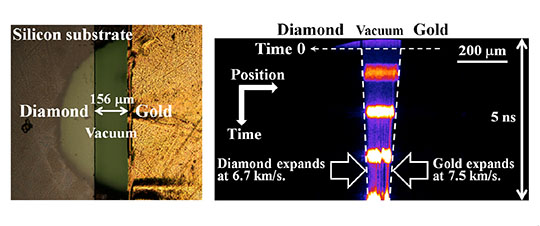
Figure 10. (Left): Front view of the target showing a diamond foil and a gold foil mounted on a silicon substrate with a hole. (Right): Streak camera image of the expanding gold and diamond into a vacuum. At time 0, the ions heat both gold and diamond instantaneously, triggering them to expand into a vacuum.
The team used the streaked image to measure the expansion speeds of gold and diamond. Computer simulations indicate that the measured speeds correspond to 64,000 (±6,000) K for gold and 20,000 (±1,000) K for diamond. The expected plasma temperatures using the total deposited energy into the cold targets and SESAME equation-of-state (EOS) tables are in good agreement with the plasma temperatures determined by their expansion speeds. This constitutes a new technique for determining the temperature of warm dense plasmas.
This approach also enables equation-of-state measurements to be made in difficult-to-access experimental regimes by uniformly and instantaneously heating a solid-density target beyond 10,000 K. The uniformly heated warm dense matter target is also a good candidate for conductivity and opacity measurements. Astrophysicists might find such targets to be useful for validating their understanding of the conditions of giant planet interiors. The warm dense plasmas also could be directly used for stopping power measurements benefiting nuclear physics.
This work involved a Lab-wide collaboration: Engineered Materials (MST-7) prepared the targets, Eulerian Codes (XCP-2) and Plasma Theory and Applications (XCP-6) performed computer simulations, S. Crockett (Physics and Chemistry of Materials, T-1) and K. G. Honnell (Materials and Physical Data, XCP-5) provided SESAME EOS tables, and Plasma Physics (P-24) researchers used the Trident Laser Facility to conduct experiments.
Reference: “Visualization of Expanding Warm Dense Matter Heated Isochorically by Laser-generated Ion Beams,” LA-UR-15-20385 (2015). Authors include: W. Bang (Plasma Physics, P-24), P. A. Bradley (Plasma Theory and Applications, XCP-6), D. C. Gautier (P-24), S. Palaniyappan (P-24), E. L. Vold (Eulerian Codes, XCP-2), M. A. Santiago Cordoba and C. E. Hamilton (Engineered Materials, MST-7), B. J. Albright (XCP-6), and J. C. Fernández (P-24).
This work was performed at LANL, and was supported by the Laboratory Directed Research and Development (LDRD) program. The work supports the Lab’s Nuclear Deterrence Nuclear and Particle Futures and the Materials for the Future science pillars for the Lab’s overall national security mission. Technical contact: Woosuk Bang
Theoretical
Understanding how HIV infection can be controlled without drug therapy
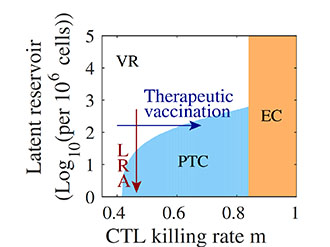
Figure 12. Therapeutic interventions may promote post-treatment control in HIV-infected patients. Post-treatment control (PTC), no control/viral rebound (VR), or elite control (EC) depend on the latent reservoir size at treatment termination, L0, and the CTL killing rate, m. The red arrow indicates the action of latency reversing agents (LRAs), which aim to decrease the latent reservoir size, thus promoting post-treatment control. The blue arrow indicates the action of therapeutic vaccination, which aims to strengthen immune responses and specifically, here, the CTL killing rate m, thus promoting post-treatment control. The black, dashed arrow indicates the potential combined effect of LRAs and therapeutic vaccination to promote post-treatment control.
Combination antiretroviral therapy is used to treat and control HIV infection, but its long-term therapeutic success varies. Some “post-treatment controller” individuals can control the virus to undetectable levels following treatment cessation, whereas others experience viral rebound. A third group of rare “elite controllers” are able to control their infections even in the absence of treatment. Understanding the circumstances surrounding treatment outcomes is one important way of illuminating paths for improving patient responses. Researchers Jessica Conway and Alan Perelson used mathematical models to explore and gain insight into these mechanisms. The journal Proceedings of the National Academy of Sciences published the findings.
Conway and Perelson developed a mathematical model of within patient HIV infection and treatment that included an immune response. The researchers numerically explored a set of ordinary differential equations with realistic parameters. They designed the work to test the hypothesis that post-treatment controllers are successful because their latent HIV-infected cell population is small, and produces productively infected cells rarely enough for their cytotoxic T lymphocytes (CTLs) to manage.
The team showed that antiretroviral treatment outcomes may depend on a balance between the number of latently HIV-infected cells and how effectively the patient’s cytotoxic T lymphocytes (CTLs) control emerging HIV infection. By varying cytotoxic T lymphocyte efficacy and size of the latent HIV reservoir, their model could reproduce the full range of observed post-infection HIV outcomes: post-treatment control, post-treatment viral relapse, and natural pre-treatment control by a group of elite controllers. The model exhibited what is called bistability, i.e. having two possible stable viral levels when a treated patient is taken off of therapy, one high corresponding to viral rebound and one low corresponding to post-treatment control. Individuals whose latent HIV-infected cell class is too large, or who have weak CTL responses, are not able to effectively quash new productively infected cells. Conway and Perelson’s model underscores the slow rate at which productively infected HIV cells emerge, explaining the lag between treatment cessation and viral relapse for individuals who are not post-treatment controllers. It also shows the important role latently infected cells and antiretroviral treatment regimes play in driving the within-host dynamics of HIV.
The research provides the first explanation of the phenomenon of post-treatment control of HIV infection. The model also made a number of experimentally testable suggestions about how to increase the fraction of treated patients who attain post-treatment control.
Reference: “Post-Treatment Control of HIV Infection,” Proceedings of the National Academy of Sciences 112, 5467 (2015); doi: 10.1073/pnas.1419162112. Authors: Alan Perelson (Theoretical Biology and Biophysics, T-6) and Jessica Conway (former postdoc in T-6, now Assistant Professor at Pennsylvania State University).
The National Institutes of Health funded the research, which supports the Lab’s Global Security mission area and the Information, Science, and Technology science pillar through the development of models of the treatment of disease. Technical contact: Alan Perelson









